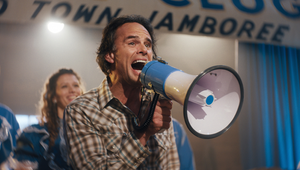
What the Cannes Lions Winners Show Us About Creativity That Converts

I’ve learned a lot in my two years serving as a judge at the Cannes Lions Festival of Creativity. First as a member of the Creative Commerce jury and then as president of the category, I've had a front-row seat to what separates the exceptional from the merely good.
Consider this: only about 10% of entries make it onto the Cannes Festival shortlist, and an even smaller fraction—just 3%—take home hardware and the coveted Lions.
One of the more revealing things that struck me is that the most awarded work consistently delivers meaningful business impact.
This isn’t mere coincidence. When we examine what makes ad campaigns both award-worthy and business-effective, patterns emerge that all marketers can learn from — regardless of whether trophies are your aim.
What (Still) Matters in Cannes
Excellence in creative commerce is an indispensable quality at Cannes. And 'commerce' is the operative word. These are not times for 'arts for art's sake' marketing.
In 2024, community commerce thrived both online and offline. (Yes, offline still matters too. Greatly, in fact.) That ability to thrive rests on blending traditional advertising that taps into advanced digital tools to spur audience engagement. There’s no 'one-size-fits-all' when it comes to awards. But as I’ve found, there are some common threads among winners. For one thing, engaging ads tend to solve people’s genuine needs. Meeting that creative threshold means acting as a brand of service. This is the surest way to drive business results: by winning both hearts and share of wallet.
All of that speaks to another theme: the convergence of content and commerce. That synthesis has enabled brands to create multi-channel experiences that boost both favourability and sales. It’s fascinating to see the transformation of utilitarian platforms like delivery apps into content distribution channels. Again, it works because both the art and science satisfy consumers’ emotional and practical needs. Besides, real-time commerce lets brands capitalize on cultural moments for immediate sales impact.
Respective branding and performance principles remain essential. But for 2025, the bar has risen for both sides. That’s why the Cannes awards winners will show how intertwined those objectives are.
This year’s winners will express a 'Yes, and…' approach. It’s all about embracing bedrock foundations and synthesising them with new methods and focus to create a whole new territory.
I’ve broken it down into three imperatives for award winners:
1. Weaving in Greater Intelligence
The most compelling entries this year reflect a sophisticated application of intelligence. Whether through AI implementation or deeper human insights, winners will make campaigns smarter from ideation through execution.
This isn’t a display of tech because it’s 'cool.' It's about using intelligence to substantively deliver unexpected value back to consumers. The strongest contenders use AI and data not just to target more effectively, but to create genuinely better experiences that address actual experiences and needs.
The best work makes this intelligence nearly invisible. Like the elegance of a truly seamless checkout process, the technology enhances the human experience without calling attention to itself. The result is marketing that feels less like marketing and more like a valuable service.
2. Commerce That Builds Lasting Loyalty
Let’s call this the 'Era of Loyalty 3.0.' Transactional commerce is evolving into relationship commerce. The most innovative campaigns recognise that every touchpoint is an opportunity to deepen customer connection, not just drive an immediate sale.
Last year’s Grand Prix Creative Commerce winner, Renault’s 'Cars to Work,' is an excellent example of this approach. The ad zeroed in on a fundamental paradox: you need a job to finance a car, but you need a car to get to work. So Renault created a solution that generated immediate business while establishing meaningful, lasting relationships with communities across France.
This year’s standouts will be expected to show that loyalty isn't just a program; it’s an outcome of consistently exceeding customer expectations and wants in distinctive ways. They’re creating virtuous cycles where commerce drives loyalty, which in turn drives sustained commerce.
3. Doubling Down on Brand Truth
The media world is always becoming more fragmented. Campaigns that break through can’t try to be everything to everyone. Instead, they’ve got to double down on authentic brand truths that connect with consumers on a deeper level.
Forget lofty purpose statements that appear to come out of left field. If a stated mission doesn’t reflect a brand’s core offerings, consumers will see right through it within a nanosecond. Understanding who you are as a brand, what you genuinely stand for, and how you can entertain and engage fans in ways that feel true to your identity is the only thing that works. There are no shortcuts, no jumpstarts to success. The line from brand essence to customer experience needs to be something everyone can see.
In practice, this means we're seeing fewer campaigns attempting to hijack cultural moments and more creating experiences that reflect genuine brand DNA. The result is work that feels more distinctive and ownable – marketing that couldn't possibly come from any other brand.
Beyond Category Boundaries
No matter your industry — automotive, consumer goods, B2B, or beyond — these principles apply universally. The shared goal remains winning hearts through marketing innovation while driving commercial value. This requires mastery of evolving trends and deep insight into customer mindsets.
Advertisers are all noticing a rapid shift toward more dynamic, human-centred commerce models. In this world, the winners aren’t just adapting, they’re helping define what comes next. They’re creating collaborative commerce mindsets that forge meaningful connections between brands and consumers, often involving strategic partnerships that extend beyond traditional marketing boundaries.
What truly distinguishes the 3% isn't polish or production value — it’s vision that’s grounded in specific outcomes that build and maintain brand value and convey the value of a product or service in real life.















